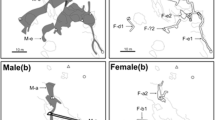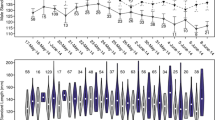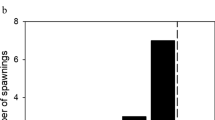Abstract
We investigated male sexual behaviour and the cost of sexual harassment, as measured by the reduction of female feeding time in the presence of a male, in a cave-dwelling population of Poecilia mexicana, in which sexual harassment does not occur naturally. We asked whether the lack of sexual harassment in this population is due to low sexual activity of the males, or low feeding motivation of the females. We experimentally increased the sexual activity of males or the females’ feeding motivation, or we used a combination of both treatments. Female feeding time was not lower in the presence of a male than in the presence of a female after sexual deprivation of the males or food deprivation of the females. Only in the combined experiment was female feeding time lower in the presence of a large male than in the presence of a small male, indicating a weak effect of sexual harassment by large males. Virgin females did not suffer a cost of sexual harassment, indicating that sexual experience does not cause the lack of sexual harassment in cave mollies. Males from a surface population, where sexual harassment occurs, significantly reduced the feeding time of cave-dwelling females even though these males exhibited surprisingly little sexual behaviour. The sexual activity of cave mollies did not correlate with male body size in any experiment, indicating that even after sexual deprivation, small cave molly males do not switch to the “alternative” mating behaviour known in surface-dwelling P. mexicana, where sexual activity is correlated negatively with male body size.
Similar content being viewed by others
References
Bisazza A (1993) Male competition, female mate choice and sexual size dimorphism in poeciliid fishes. Mar Behav Physiol 23:257–286
Bisazza A, Pilastro A (1997) Small male mating advantage and reversed size dimorphism in poeciliid fishes. J Fish Biol 50:397–406
Clutton-Brock TH, Parker GA (1995) Sexual coercion in animal societies. Anim Behav 49:1345–1365
Dominey WJ (1984) Alternative mating tactics and evolutionary stable strategies. Am Zool 24:385–396
Eberhard WG (2002) The function of female resistance behavior: Intromission by male coercion vs. female cooperation in sepsid flies (Diptera: Sepsidae). Rev Biol Trop 50:485–506
Farr JA (1989) Sexual selection and secondary sexual differentiation in Poeciliids: determinants of male mating success and the evolution of female choice. In: Meffe GK, Snelson FF Jr (eds) Ecology and evolution of livebearing fishes (Poeciliidae). Prentice Hall, Englewood Cliffs, N.J., pp 91–123
Farr JA, Travis J, Trexler JC (1986) Behavioural allometry and interdemic variation in sexual behaviour of the sailfin molly, Poecilia latipinna (Pisces: Poeciliidae). Anim Behav 34:497–509
Fox EA (2002) Female tactics to reduce sexual harassment in the Sumatran orangutan (Pongo pygmaeus abelii). Behav Ecol Sociobiol 52:93–101
Franck D (1975) Der Anteil des “Coolidge-Effektes” an der isolationsbedingten Zunahme sexueller Verhaltensweisen von Poecilia sphenops. Z Tierpsychol 38:472–481
Gabor CR (1999) Association patterns of sailfin mollies (Poecilia latipinna): alternative hypotheses. Behav Ecol Sociobiol 46:333–340
Gabor CR, Page R (2003) Female preference for large males in sailfin mollies, Poecilia latipinna: the importance of predation pressure and reproductive status. Acta Ethol 6:7–12
Gordon MS, Rosen DE (1962) A cavernicolous form of the poeciliid fish Poecilia sphenops from Tabasco, Mexico. Copeia 1962:360–368
Griffiths SW (1996) Sex differences in the trade-off between feeding and mating in the guppy. J Fish Biol 48:891–898
Gross MR (1984) Sneakers, satellites and parentals: polymorphic mating strategies in North American sunfishes. Z Tierpsychol 60:1–26
Gross MR (1996) Alternative reproductive strategies and tactics: diversity within sexes. Trends Ecol Evol 11:92–98
Houde AE (1997) Sex, color and mate choice in guppies. Princeton University Press, Princeton, N.J.
Hughes AL (1985) Male size, mating success, and mating strategy in the mosquitofish Gambusia affinis (Poeciliidae). Behav Ecol Sociobiol 17:271–278
Jormalainen V, Merilaita S (1995) Female resistance and duration of mate-guarding in three aquatic peracarids (Crustacea). Behav Ecol Sociobiol 36:43–48
Krupa JJ, Leopold WR, Sih A (1990) Avoidance of male giant water striders by females. Behaviour 115:247–253
Magurran AE (2001) Sexual conflict and evolution in Trinidadian guppies. Genetica 112–113:463–474
Magurran AE, Seghers BH (1994) A cost of sexual harassment in the guppy, Poecilia reticulata. Proc R Soc Lond B Biol Sci 258:89–92
Marler CA, Ryan MJ (1997) Origin and maintenance of a female mating preference. Evolution 51:1244–1248
Matthews IM, Magurran AE (2000) Evidence for sperm transfer during sneaky mating in wild Trinidadian guppies. J Fish Biol 56:1381–1386
McLain DK, Pratt AE (1999) The cost of sexual coercion and heterospecific sexual harassment on the fecundity of a host-specific, seed-eating insect (Neacoryphus bicrucis) Behav Ecol Sociobiol 46:164–170
Menzel BM, Darnell RM (1973) Systematics of Poecilia mexicana (Pisces: Poeciliidae) in Northern Mexico. Copeia 2:225–237
Parzefall J (1969) Zur vergleichenden Ethologie verschiedener Mollienesia-Arten einschließlich einer Höhlenform von Mollienesia sphenops. Behaviour 33:1–37
Parzefall J (1970) Morphologische Untersuchungen an einer Höhlenform von Mollienesia sphenops (Pisces, Poeciliidae). Z Morphol Tier 68:323–342
Parzefall J (1974) Rückbildung aggressiver Verhaltensweisen bei einer Höhlenform von Poecilia sphenops (Pisces, Poeciliidae). Z Tierpsychol 35:66–84
Parzefall J (1979) Zur Genetik und biologischen Bedeutung des Aggressionsverhaltens von Poecilia sphenops (Pisces, Poeciliidae). Z Tierpsychol 50:399–422
Parzefall J (1993) Schooling behaviour in population-hybrids of Astyanax fasciatus and Poecilia mexicana (Pisces, Characidae and Poeciliidae). In: Schröder H, Bauer M , Schartl M (eds) Trends in Ichthyology. GSF, Bericht, pp 297–303
Persaud KN, Galef BG (2003) Female Japanese quail aggregate to avoid sexual harassment by conspecific males: a possible cause of conspecific cueing. Anim Behav 65:89–94
Peters N, Peters G, Parzefall J, Wilkens H (1973) Über degenerative und konstruktive Merkmale bei einer phylogenetisch jungen Höhlenform von Poecilia sphenops (Pisces, Poeciliidae). Int Rev Ges Hydrobiol 58:417–436
Pilastro A, Benetton S, Bisazza A (2003) Female aggregation and male competition reduce costs of sexual harassment in the mosquitofish Gambusia holbrooki. Anim Behav 65:1161–1167
Plath M, Körner KE, Schlupp I, Parzefall J (2001) Sex recognition and female preferences of cave mollies Poecilia mexicana (Poeciliidae, Teleostei) in light and darkness. Mem Biospeol 28:163–167
Plath M, Parzefall J, Schlupp I (2003) The role of sexual harassment in cave and surface-dwelling populations of the Atlantic molly, Poecilia mexicana (Poeciliidae, Teleostei). Behav Ecol Sociobiol 54:303–309
Plath M, Parzefall J, Körner KE, Schlupp I (2004a) Sexual selection in darkness: female mating preferences in surface- and cave-dwelling Atlantic mollies, Poecilia mexicana (Poeciliidae, Teleostei). Behav Ecol Sociobiol 55:596–601
Plath M, Arndt M, Parzefall J, Schlupp I (2004b) Size-dependent male mating behaviour in the cave molly, Poecilia mexicana (Poeciliidae, Teleostei). Subterr Biol 2:59–64
Ptacek M (2002) Patterns of inheritance of mating signals in interspecific hybrids between sailfin and shortfin mollies (Poeciliidae: Poecilia: Mollienesia). Genetica 116:329–342
Ptacek MB, Travis J (1997) Mate choice in the sailfin molly, Poecilia latipinna. Evolution 51:1217–1231
Reale D, Bousses P, Chapuis JL (1996) Female-biased mortality induced by male sexual harassment in a feral sheep population. Can J Zool 74:1812–1818
Rowe L, Arnqvist G, Sih A, Krupa JJ (1994) Sexual conflict and the evolutionary ecology of mating patterns: water striders as a model system. Trends Ecol Evol 9:289–293
Ryan MJ, Causey BA (1989) “Alternative” mating behavior in the swordtail Xiphophorus nigrensis and Xiphophorus pygmaeus (Pisces: Poeciliidae). Behav Ecol Sociobiol 24:341–348
Ryan MJ, Pease CM, Morris MR (1992) A genetic polymorphism in the swordtail Xiphophorus nigrensis: testing the prediction of equal fitnesses. Am Nat 139:21–31
Schlupp I, Marler C, Ryan MJ (1994) Benefit to male sailfin mollies of mating with heterospecific females. Science 236:373–374
Schlupp I, Mc Knab R, Ryan MJ (2001) Sexual harassment as a cost for molly females: bigger males cost less. Behaviour 138:277–286
Shine R, O’Connor D, Mason RT (2000) Sexual conflict in the snake den. Behav Ecol Sociobiol 48:392–401
Smuts BB, Smuts RW (1993) Male aggression and sexual coercion of females in nonhuman primates and other mammals: evidence and theoretical implications. Adv Stud Behav 22:1–63
Sparkes TC, Keogh DP, Haskins KE (2000) Female resistance and male preference in a stream-dwelling isopod: effects of female molt characteristics. Behav Ecol Sociobiol 47:145–155
Sparkes TC, Keogh DP, Orsburn, TH (2002) Female resistance and mating outcomes in a stream-dwelling isopod: effects of male energy reserves and mating history. Behaviour 139:875–896
Taborsky M (1994) Sneakers, satellites and helpers: parasitic and cooperative behavior in fish reproduction. In: Slater PJP, Rosenblatt JS, Snowdon CT, Milinski M (eds) Advances in the study of behavior. Academic, San Diego, pp 1–100
Travis J (1994) Size-dependent behavioural variation and genetic control within and among populations. In: Boake CRB (ed) Quantitative genetic approaches to animal behavior. University of Chicago Press, Chicago, pp 165–187
Travis J, Woodward BD (1989) Social context and courtship flexibility in male sailfin mollies, Poecilia latipinna (Pisces: Poeciliidae). Anim Behav 38:1001–1011
Weber A, Proudlove GS, Parzefall J, Wilkens H, Nalbant TT (1998) Morphology, systematic diversity, distribution and ecology of stygobitic fishes. In: Juberthie C, Decu V (eds) Encyclopaedia biospeologica, vol II. Société de Biospéologie, Bucharest
Witte K, Ryan MJ (1998) Male body length influences mate-choice copying in the sailfin molly Poecilia latipinna. Behav Ecol 95:534–539
Woodhead AD, Armstrong N (1985) Aspects of the mating behaviour of male mollies (Poecilia spp.). J Fish Biol 27:593–601
Zimmerer EJ, Kallman KD (1989) Genetic basis for alternative reproductive tactics in the pygmy swordtail, Xiphophorus nigrensis. Evolution 43:1298–1307
Acknowledgements
We thank the Mexican Government for issuing permits (#242-219, 276/36, 210696-213-03). A. Taebel-Hellwig, T.H. Dirks, I.D. Schmidt, and the Aquarium team provided animal care and technical support. A. Berglund and an anonymous reviewer provided valuable comments. Financial support came from the University of Hamburg (M.P.). I.S. was a Heisenberg fellow of the DFG. Our experiments comply with the current laws of Germany.
Author information
Authors and Affiliations
Corresponding author
Additional information
Communicated by R.F. Oliveira
Rights and permissions
About this article
Cite this article
Plath, M., Brümmer, A. & Schlupp, I. Sexual harassment in a live-bearing fish (Poecilia mexicana): influence of population-specific male mating behaviour. acta ethol 7, 65–72 (2004). https://doi.org/10.1007/s10211-004-0102-4
Received:
Revised:
Accepted:
Published:
Issue Date:
DOI: https://doi.org/10.1007/s10211-004-0102-4




